KA-BOOM 🎆 A story about Near-Earth Supernovae ✨ Eine Geschichte über erdnahe Supernovae [ENG/GER]
Near-Earth is quite an expandable term when it comes to astronomical distances, especially if we put that term in correlation with Supernovae. Supernovae are extremely bright events that occur at the end of a massive star´s life. For a short period of time, a single star can become as bright as a galaxy. That is why those events can be observed with the naked eye. The brightness is also where they got their names from. It originates from Latin "nova" which means "new". A new object on the sky is born. The last Supernova that was visible with the naked eye happened in 1987 - we will explore that event in more detail on the following pages.
Erdnahe ist ein dehnbarer Begriff wenn es um astronomische Entfernungen geht, und besonders im Zusammenhang mit Supernovae.
Supernovae sind extrem helle Ereignisse, welche am Ende des Lebens eines massereichen Sterns stattfinden. Für einen kurzen Moment leuchtet ein einzelner Stern so hell wie eine ganze Galaxie. Das ist auch der Grund, warum diese Ereignisse mit dem freien Auge beobachtet werden können. Die Helligkeit ist außerdem für die Namensgebung verantworltich. Das Wort "nova" kommt aus dem Lateinischen für "neu". Ein neues Objekt ist am Himmel geboren. Die letzte Supernova, welche mit freiem Auge sichtbar war geschah im Jahr 1987. Wir werden uns aus den folgenden Seiten näher mit diesem Ereignis befassen.
Supernova 1987A in the Large Magellanic Cloud
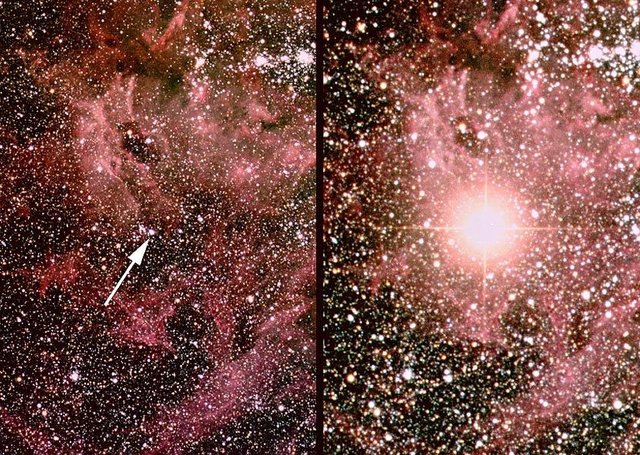
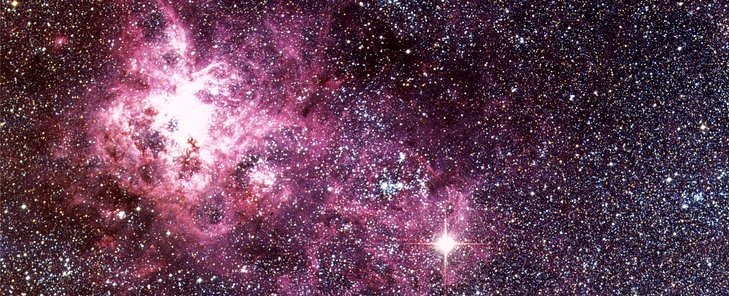
On the left side of the upper image you can see the progenitor star "Sanduleac" before its explosion. It was a blue supergiant of category B3 (=very massive). And indeed the explosion was one of the brightest stellar events detected since the invention of the telescope about 400 years ago. On the lower pic, you can see the explosion as it was observable with a common telescope. The Large Magelanic cloud is about 167,000 light-years away from us and therefore not part of our own galaxy, the milky way.
Auf der linken Seite des oberen Bildes kannst du den Urpsrungsstern "Sanduleac" vor seiner Explosion sehen. Er war ein blauer Superriese der Kategorie B3 (= sehr massiv). Und tatsächlich war die Explosion eines der hellsten stellaren Ereignisse, welches seit der Erfindung des Teleskops vor 400 Jahren beobachtet wurde. Am unteren Bild kannst du die Explosion sehen, wie sie mit einem gewöhnlichen Teleskop ausgesehen hat. Die große Magellansche Wolke ist rund 167,000 Lichtjahre von uns entfernt, und somit nicht mehr Teil unserer eigenen Galaxie, der Milchstraße.
Evolution of the SN 1987A and as it is seen today
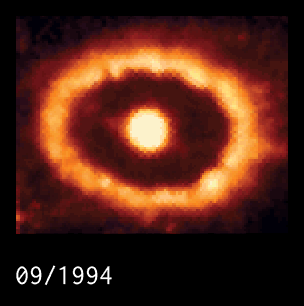
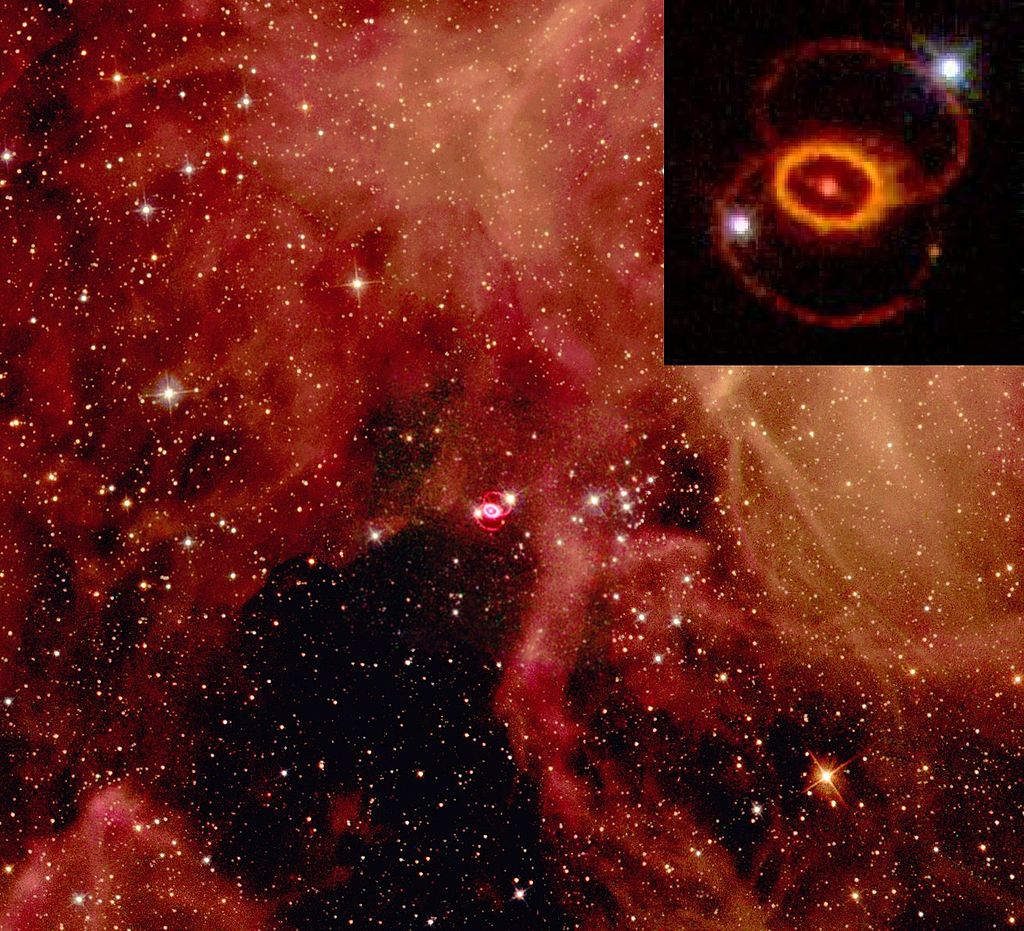
In the upper animation you can see the development of the SN remnant over a period of 15 years, until 2009, the year of the launch of Bitcoin :D
In the lower pic you can see how the SN 1987A looks as of now.
In the lower pic you can see how the SN 1987A looks as of now.
In der oberen Animation kannst du die Entwicklung der Supernova über einen Zeitraum von 15 Jahren sehen, bis 2009, dem Geburtsjahr von Bitcoin :D
Im unteren Bild siehst du, wie die SN 1987A heute aussieht.
Im unteren Bild siehst du, wie die SN 1987A heute aussieht.
So, SN 1987A was the last SN that was observable with the naked eye, even though you had to look very closely because of it´s great distance. But back in the year 1054 Chinese astronomers witnessed a Supernova so bright, it was visible during day and remained that bright for around 2 years. So obviously the SN 1054 occurred much closer to Earth, indeed it happened only 6,500 light-years away from us. The remnant is still visible in the constellation Taurus, known as crab nebula.
Another candidate of near-Earth supernovae happened around 1,200 BC but was discovered only recently in 1998. Unfortunately there is no historical record of it. It got the ringing name RX J0852.0-4622 - but it´s special because it´s only 660 light-years away, which is VERY close for a supvernova. Supernovae so close are meant to happen only once every 100,000 years - but can be called "Near-Earth" without hesitation.
Die SN 1987A war also die letzte SN, welche mit freiem Auge beobachtet werden konnte, auch wenn du auf Grund ihrer Entfernung ganz genau hinsehen musstest. Doch im Jahre 1054 wurde von chinesischen Astronomen eine Supernova beobachtet, die so hell war, dass sie sogar tagsüber sichtbar war. Und für 2 Jahre sichbar blieb. Offensichtlich muss die SN 1054 also viel näher gewesen sein, und tatsächlich ist sie in einer Entfernung von rund 6,500 Lichtjahren geschehen.Another candidate of near-Earth supernovae happened around 1,200 BC but was discovered only recently in 1998. Unfortunately there is no historical record of it. It got the ringing name RX J0852.0-4622 - but it´s special because it´s only 660 light-years away, which is VERY close for a supvernova. Supernovae so close are meant to happen only once every 100,000 years - but can be called "Near-Earth" without hesitation.
Ein weiterer Kandidat für eine erdnahe Supernova geschah rund 1,200 vor Christus, wurde aber erst kürzlich entdeckt, nämlich um 1998. Leider gibt es zu dieser SN keine historischen Aufzeichnungen. Sie bekam den klingenden Namen RX J0852.0-4622 - ist aber etwas ganz besonderes, da sie in nur 660 Lichtjahren Entfernung geschah und somit ohne bedenken eine erdnahe Supernova genannt werden kann. Supernova in solch nahen Entfernungen sollten nur alle 100,000 Jahre stattfinden.
SN 1054 also known as "crab nubula"
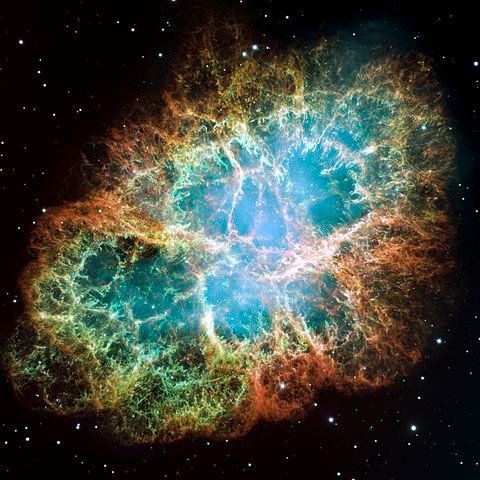
RX J0852.0-4622
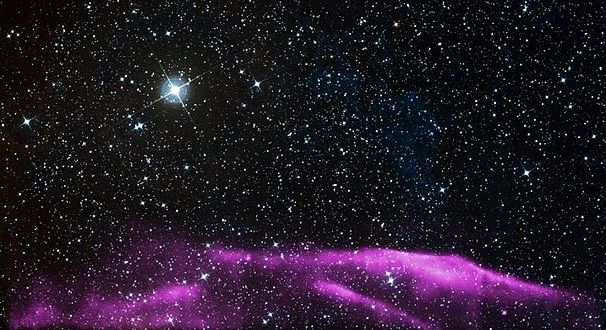
Hi, ich bin selbst Luft und Raumfahrttechniker, aber habe es aus Mangel an Interesse vermieden mich mit Astronomie zu beschäftigen. Die Bilder sehen echt toll aus. Jetzt muss ich echt mal schauen das ich im Master bisschen mich damit beschäftige. Dein Post hat mich echt neugierig gemacht. Danke dafür. :)
Grüße aus Stuttgart
Ibi
An feinen Bildern mangelt es in der Astronomie nicht. Das Universum ist voll von Juwelen 🙂
Freut mich dass ich dir mit dem Beitrag Lust auf mehr machen konnte 👌
wow, wirklich fantastisch :) Ich wusste vor ein paar Stunden noch nicht mal, dass du von Beruf Astronom bist, hätte geglaubt du machst das hobbymäßig :D Mich interessiert das Thema auch extrem, hab sogar schon überlegt ob ich als Nebenstudium Astronomie an der Universität Wien machen soll...
Jedenfalls wirklich schöner Artikel, der auch gerne Regesteemed wird! (Falls es dieses Wort gibt) :D
Im Universum gibt's viel, daher auch sicher dieses Wort, vielen Dank!
Was studierst du? wenn Naturwissenschaften dann gerne nebenbei Astro, sonst eher nicht so nebenbei. Ist sehr mathematisch..
Kannst ja auch mal im Planetarium vorbei schauen wennst magst, bin da immer am Wochenende
naja Wirtschaftsrecht, lässt sich vielleicht nicht so gut kombinieren :D Ja liebend gerne, würde mich freuen! :-)
Hi @flurgx:)
Please, would you mind adding source references for the text of the article.
Eg: The book or website you read to gather this information.
I ask this so that I may have your post reviewed and curated by the steemstem project.
Thank you
(steemstem curator)
The details (e.g. distances, occurrences, etc) are from Wikipedia, the rest is written from my mind, as I work as an astronomer 😀
Glad you dropped by and said hi! I was writing with steemstem tag few months ago, but no thing like this happened. And because @suesa loves steemstem so much I thought I'll give it another try 😀 would be cool to write for your tag from time to time.
You can start your journey here
https://en.m.wikipedia.org/wiki/Near-Earth_supernova
and proceed here
https://en.m.wikipedia.org/wiki/SN_1987A
Thank you for responding:)
Wow, that is a really awesome job:)
I understand when you say it is from your mind, but you did have to study the subject for it to be from your mind:)
May be you would like to include the text from your studies:)
I think this post might help explain things better:
https://steemit.com/steemstem/@steemstem/being-a-member-of-the-steemstem-community
@zest nope sorry, not quite getting your point. I left university 10 years ago, working at the public planetarium and observatories in Vienna right now. SN 1987A is one aspect of a show in the planetarium, so I though I investigate a little deeper (via Wikipedia, the links I provided) and the above is the outcome.
If you check the text again, there is more general knowledge in it than specific knowledge. Knowledge that just accumulated over time in my brain and isn't from a single book, like "supernovae from a-z" 😀
I so love your job, I am studying astronomy part time atm:)
Ok, I think I will be able to motivate the reasoning behind your astronomy posts in the future. Would mind just adding the wiki links in the future and signature or something for readers to know your qualifications please:)
Thank you for responding.
Sure I can add that to this post as well as future posts 😋 guess I have to check out your rocket chat channel as well 😀
Ich lass mich immer wieder gern von dir in ferne Galaxien entführen...
Wieder so ein "Hab ein bisschen was gelernt - Falls ich mal bei Assinger sitze, könnte das helfen!"-Gefühl :D Guter Post, danke!
^^
ich hoffe du bewirbst dich regelmäßig beim Assinger, damit du auch mal wirklich dort sitzt und mit deiem flurgx´schen wissen abstauben kannst ;)
danke für´s vorbei schauen! meeting heute war nett, aber kurz (für mich)
The universe never fails to inspire and is full of surprises. I wonder when can man finally be able to travel smoothly from one dimension to another; or is that only wishful thinking? Thank you so much for your interesting post! I look forward to more of your mind-blowing posts in the future. Keep on steeming!
mind-blowing posts ^^
i hope your mind is still there ... even though i am a friend of the no-mind meditative state of being
watching pictures from space heps me with that
star travaelling is definitely not wishful thinking, but we first need peace on Earth before we can venture into space! blessings dear
Werden und Vergehen. Obwohl so eine Supernova oder gar PISN mit Gammablitz schon ein würdiger Abgang ist. Resteem
Faszinierend, dass eine Supernova über Jahre sichtbar sein kann.
Wahnsinnig interessanter Post!! Unglaublich faszinierend solche Super Novae! Da bekomm ich wieder einmal irrsinnig Lust drauf mir ein Teleskop zu kaufen :D
da biste mit den bildern ausm netz und einem besuch auf der sternwarte besser dran ...
die beobachtungen mit dem teleskop find ich immer so n bisschen mäh ..
auf willhaben gibt´s gute zum guten preis! 2-3 hundert solltest schon investerien
Ah verstehe. Ja, dass ich mit einem Amateurteleskop mit solchen Bildern nicht mit kann, hab ich befürchtet :D
Aber irgendwann muss ich dir eh mal einen Besuch im Planetarium abstatten! ;)
Gut zu wissen, danke für die Tipps!!
Woa das Teil sieht ja irgendwie geil aus, richtig richtig cool.
Krass wie selten sowas ist und wie ultralange her.
Ich find die Sache mit dem Universum immer etwas spooky...ist es nun endlich oder nicht und überhaupt...grusel